Hospice. Later, respite care for the frail and elderly. Now a nursing home.
At the end of 1901 a dying woman had been admitted to the Mission House, but there was little room in the building for such people, who had nowhere else to go. Therefore, in April 1902, the Sisters opened the Home of the Compassion of Jesus (Home for the Dying Poor) at No. 48 Douglas Street, Deptford.
The Community had begun to seek new premises and took an interest in Hampton Court House in Richmond, which had been vacant for a few years. In the event, Boyle House Farm at Thames Ditton was purchased for £5,000. However, the mortgage was large and there were no funds to equip the building as a Home for the dying.
In the meantime, in February 1905, to provide more space for a hospice for the worthy poor, the Sisters rented a house - No. 37 Warrington Crescent in Maida Vale - for five years. The new Home of Compassion was formally opened on 25th May 1905 by the Bishop of Kensington in the presence of the Duchess of Albany.
The large house, with open gardens behind, had enough rooms to accommodate 15 to 18 patients, but only 3 rooms were initially opened. The staff consisted of a paid trained nurse and 5 lady helpers, providing care for both body and soul.
By 1906 the Home had 10 patients, dying of tuberculosis or sarcoma. The patients belonged mainly to the Church of England, although one male patient was a Baptist. Catholic priests were not allowed to enter the premises.
In 1909 the owner of No. 37 decided to sell the property and the Home was obliged to vacate the building. It moved to a much smaller house with 8 rooms at No. 51 Warrington Crescent, where it had only 6 beds.
In 1912 sufficient funds had been raised to equip the Boyle House Farm in Thames Ditton. Twelve patients were transferred there from London.
The new Home of Compassion, a Georgian mansion built around 1786, stood in 2 acres of grounds and included stables and outbuildings. Its main entrance was in Boyle Farm Road.
In 1925 a large chapel was built.
In 1935, when the Home had 50 beds, plans were made to extend it to create an extra 20 beds, An Appeal to raise £6,000 for the project began in November. However, WW2 intervened in 1939 and the plans were shelved.
In 1948 the Home was disclaimed from the NHS and remained independent.
In 1956 the weekly cost of an in-patient was £7 18s 8d (£7.93). By 1959 this had increased to £9 7s 11d (£9.40).
In 1960 the Home had 53 beds.
By 1968 the Community of the Compassion of Jesus had diminished; only three Sisters remained, one of whom also ran the nearby St Agnes Children's Home (see below). With no new novices and with bankruptcy approaching, the order was dissolved. Management of the Home was relinquished and passed to an interdenominational charity under the patronage of the Bishop of Guildford. The lay committee placed the finances of the Home on a sounder footing. Half the patients came from London boroughs and the rest from Surrey.
In 1970 the Home had 50 beds. In 1971 the nursing staff consisted of 6 SRNs, 3 SENs, 10 auxiliary nurses and 2 orderlies. The kitchen and domestic staff numbered 12, including a chef and a gardener.
In 1973 a large sitting room was converted into a new ward. Work began on a new kitchen.
In 1978 the nursing staff comprised 4 SRNs, 4 SENs and 25 nursing auxiliaries; there were 14 domestic staff, and 5 house and administrative staff.
The weekly fees in 1981 were £90 (the economic rate would have been £115 to £125, but most patients were subsidized).
An Appeal was launched to raise £100,000 so that repairs and improvements could be carried out to the building. A new hot water system was installed, as well as new bathrooms and WCs. A new ward, named Thameside, was fitted with adjustable height beds, reading lamps, cubicle curtains and purpose-built furniture. The other wards were similarly upgraded.
In 1982 the main entrance to the Home was still in Boyle Farm Road. Patient accommodation consisted of two 6-bedded wards, three 5-bedded wards, two 3-bedded wards and 5 single rooms (for private patients). Most patients were aged in their late 80s. The staff comprised 3 full-time and 5 part-time SRNs, 2 full-time SENs and 3 night nurses, a cook and an assistant. Only patients were catered for - the staff provided their own food.
The Home had its own G.P. surgery, run by the local doctor and housed in the old stable block, now known as the Priory. The block also contained a chapel, cloisters and a laundry.
In 1987 the Home had 46 beds. The shortage of staff meant that the wards and day rooms had to be reorganised. A new staff apartment was made in the Priory.
A new Nurses' Sitting Room was created in 1988. Double glazing was installed in the Home, as well as a new kitchen range. By this time nearly all the patients were supported by the D.H.S.S.
In 1990 the roof of the Home needed repairs, at a cost of £12,000.
A conservatory was added to the central curved bay on the north side of the mansion in 1993.
In 2006 the charitable Trust planned to bring the Home up to the standard required by regulations, but the costs were substantial. The County Council and NHS authorities in Surrey had withdrawn their funding support, so in 2007 it was decided that the Home would be sold to Caring Homes Group, a private company.
In September 2008, following its sale, the building was declared unsafe. It closed for repairs and refurbishment, but the lack of funding left it empty.
It finally reopened in June 2016, having been extended and modernised at a cost of £12m.
Present status (February 2020)
The first Home of Compassion at No. 48 Douglas Street has long been demolished and the area completely redeveloped for new housing. Douglas Street has been renamed Douglas Way.
The site of the second Home was at No. 37 Warrington Crescent. The Grade II listed building has been divided into apartments.
No. 51 Warrington Crescent, the third site, is now also apartments.
The building in Thames Ditton - the final site of the Home - was Grade II* listed in 1953. After it closed in 2008 and was left empty, it became subject to theft and vandalism. Extensive repairs were necessary before the Home could reopen under the auspices of Caring Homes.
Update: March 2024)
The care home has now been refurbished and officially renamed Thames View. It is managed by Aria Care.
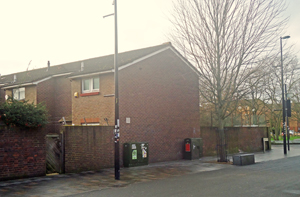
The site of the first Home of Compassion was on the corner of Douglas Way and Watson's Street (above and below).
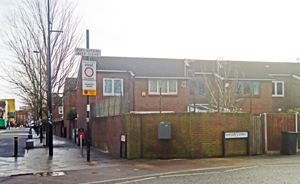
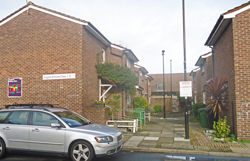
Looking towards the site from Vaughan Williams Way, off Watson's Street.
N.B. Photographs obtained in November 2019
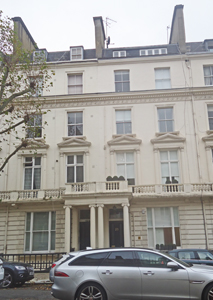
No. 37 Warrington Crescent (the left-hand doorway) was the second site of the Home.
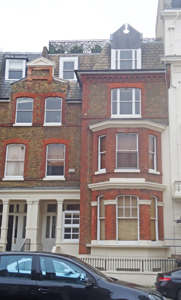
The third site of the Home, No. 51 Warrington Crescent (the right-hand doorway), is also now apartments.
N.B. Photographs obtained January 2009
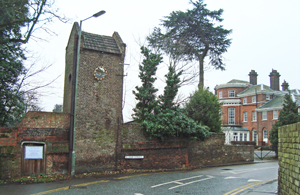
The Home, as seen approaching from Summer Road.
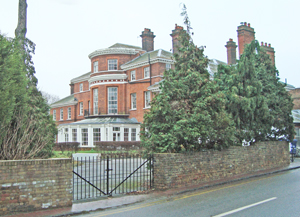
The Home occupies the triangle between Thames Ditton High Street and Boyle Farm Road. The northern side of the building (above) faces the river. When this photograph was taken the Home had been unoccupied for a year.
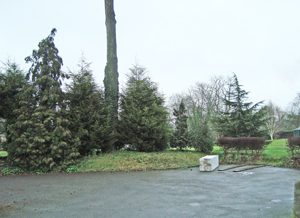
The gardens on north side lead to the river.
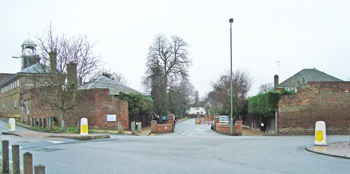
The Boyle Farm Road entrance to the Home
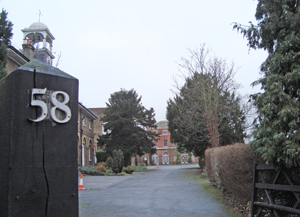
The present main entrance, marked as No. 58 High Street, is actually in the back off the Boyle Farm Road entrance.
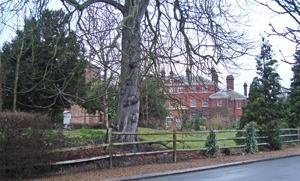
The Home, as seen from Boyle Farm Road.
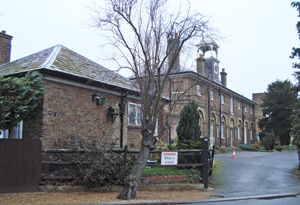
The Priory, on the right of the image, on Boyle Farm Road.

The Priory, as seen from Boyle Farm Road.
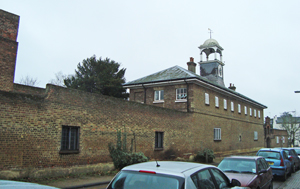
The Priory, as seen from the High Street.
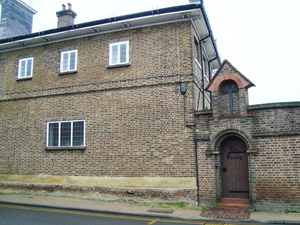
An entrance to The Priory on the High Street.

The Chapel with its own entrance on the High Street. In fact, the whole east side of the High Street is occupied by the stone walls of the premises.
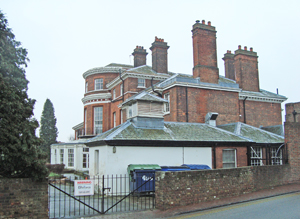
The west side of the Home, as seen from the High Street.
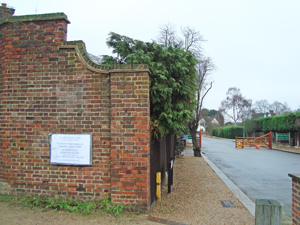
A sign at the corner of Boyle Farm Road announcing the move of the Walsingham Care charity shop to No. 68 Bridge Road, Hampton Court.
In addition to running the Home of Compassion, the Sisters of the Community of the Compassion of Jesus also managed a children's home in Weston Green Road, Thames Ditton.
In 1919 the Sisters were asked to care for a young mother and her baby. Soon more such requests followed and three rooms within the Home were set aside as nurseries.
In 1934 the Sisters bought a house in Church Walk, Thames Ditton, for use as a children's home. It soon accommodated 20 children.
In 1939 Newlands, a large house in Weston Green became available and it was decided to move the children there. However, the plan had to be abandoned beacuse of the outbreak of WW2 (1939-1945). The children were evacuated to Torquay and Newlands was requisitioned for the war effort.
In 1948 Newlands finally became the St Agnes Home for Children. Mainly for the children of broken marriages (although some were orphans), it was managed by the Sisters based at the Home of Compassion. The Sisters relied entirely on voluntary donations of money, furniture, clothing, toys and food.
At the end of 1956 it accommodated 22 children, aged from 6 months to 14 years.
The Home closed in 1968 when the Sisterhood was dissolved.
N.B. Photographs obtained in January 2020
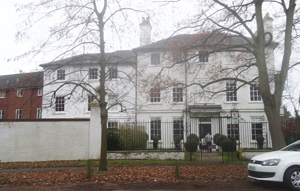
The building has been converted into apartments and is now known as The Newlands - a gated community.
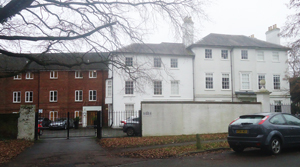
It is described as a Georgian building, but appears to have considerable 20th century extensions.
(Author unstated) 2017 St Agnes Home for Children Weston Green. Newsletter 38. Molesley Local History Society, 3.
Campbell TW 2007 Religious Communities of the Anglican Communion. Australia, New Zealand and the South Pacific. Self-published, p.27.
Collier NC 1909 Annual Report of the Medical Officer of Health for the Year 1908. London, Borough of Hammersmith, p. 132.
Harris AE 1910 Annual Report of the Medical Officer of Health for the Year 1909. London, Borough of Islington, p.111.
Lewis MJ 2006 Medicine and Care of the Dying: A Modern History. Oxford University Press.
Portlock J 2010 Serial squatters moved in to mansion. Sutton & Croydon Guardian, 31st October.
http://en.wikipedia.org
http://oliverandrobb.co.uk
https://heritageyorkproject.wordpress.com
https://historicengland.org.uk
https://residents-association.com (1)
https://residents-association.com (2)
www.alamy.com
www.ascensionlavenderhill.org.uk
www.bbc.co.uk
www.caringhomes.org
www.flickr.com
www.geograph.org.uk
www.getsurrey.co.uk
www.hospitalityassured.com
www.housingcare.org
www.linkedin.com
www.surreylife.co.uk
www.walsinghamcare.org.uk
Return to home page